# 七、常见问题
# 源代码编译打包方法
# 前端
1.安装nodejs,下载并安装nodejs:http://nodejs.cn/download/
2.下载前端源代码,将前端源代码下载到本地。
3.编译打包
- 执行登录私服命令: npm login --registry=http://119.255.194.80:8081/repository/npm-public/
- 输入用户名:vue-admin
- 输入密码:hos1234qwer
- 输入邮箱:chenyuan@mediway.cn
- 执行安装依赖命令:npm install --registry=http://119.255.194.80:8081/repository/npm-public/
4.打包:npm run build,dist目录即为打好包的前端程序,用于后续部署。
# 后端
HOS平台提供的jar包都已经上传到maven私服上,可以从私服上直接下载使用。
- 私服地址:http://119.255.194.80:8081/
- 用户名/密码:guest/guest
1.前提准备,安装并配置jdk和maven,具体版本:
- JDK: 1.8
- Maven: 3.3+
2.maven私服配置:在C盘的当前用户目录里面找到 .m2目录下的settings.xml文件(或者在maven安装目录下的conf目录里), 如果没有settings.xml的话,可以将示例文件复制到该目录中。
在
<server>
<id>nexus</id>
<username>guest</username>
<password>guest</password>
</server>
在
<mirror>
<id>nexus</id>
<name>nexus maven</name>
<url>http://119.255.194.80:8081/repository/maven-public/</url>
<mirrorOf>*</mirrorOf>
</mirror>
完整的Maven setting文件示例如下:
<?xml version="1.0" encoding="UTF-8"?>
<settings xmlns="http://maven.apache.org/SETTINGS/1.0.0"
xmlns:xsi="http://www.w3.org/2001/XMLSchema-instance"
xsi:schemaLocation="http://maven.apache.org/SETTINGS/1.0.0 http://maven.apache.org/xsd/settings-1.0.0.xsd">
<!--自定义仓库地址-->
<localRepository>D:\repository</localRepository>
<servers>
<server>
<id>nexus</id>
<username>guest</username>
<password>guest</password>
</server>
</servers>
<mirrors>
<mirror>
<id>alimaven</id>
<name>aliyun maven</name>
<url>http://maven.aliyun.com/nexus/content/groups/public/</url>
<mirrorOf>central</mirrorOf>
</mirror>
<mirror>
<id>nexus</id>
<name>nexus maven</name>
<url>http://119.255.194.80:8081/repository/maven-public/</url>
<mirrorOf>*</mirrorOf>
</mirror>
</mirrors>
<profiles>
<profile>
<id>nexus</id>
<repositories>
<repository>
<id>central</id>
<url>http://119.255.194.80:8081/repository/maven-public/</url>
<releases>
<enabled>true</enabled>
</releases>
<snapshots>
<enabled>true</enabled>
</snapshots>
</repository>
</repositories>
</profile>
<profile>
<id>aliyun</id>
<repositories>
<repository>
<id>central</id>
<url>http://maven.aliyun.com/nexus/content/groups/public/</url>
<releases>
<enabled>true</enabled>
</releases>
<snapshots>
<enabled>true</enabled>
</snapshots>
</repository>
</repositories>
</profile>
<profile>
<id>guanwang</id>
<repositories>
<repository>
<id>central</id>
<url>https://repository.sonatype.org/content/groups/public</url>
<releases>
<enabled>true</enabled>
</releases>
<snapshots>
<enabled>true</enabled>
</snapshots>
</repository>
</repositories>
</profile>
<profile>
<id>guanwang1</id>
<repositories>
<repository>
<id>central</id>
<url>https://central.maven.org/maven2</url>
<releases>
<enabled>true</enabled>
</releases>
<snapshots>
<enabled>true</enabled>
</snapshots>
</repository>
</repositories>
</profile>
<profile>
<id>guanwang2</id>
<repositories>
<repository>
<id>central</id>
<url>https://maven.atlassian.com/repository/public</url>
<releases>
<enabled>true</enabled>
</releases>
<snapshots>
<enabled>true</enabled>
</snapshots>
</repository>
</repositories>
</profile>
</profiles>
</settings>
3.下载源代码:下载后端服务的源代码到本地机器。 4.编译打包:使用mvn命令打包:
mvn clean package -Dmaven.test.skip=true
打好的jar包所在目录:
- 开放平台:hos-open-runner/target/hos-open-platform.jar
- 统一认证:hos-authserver-runner/target/hos-authserver-runner.jar
# 源代码编译问题
问题1:前端vue代码install时报错:npm ERR! code EINTEGRITY npm ERR! sha512-XXX,类似下图:

问题分析:使用不同版本nodejs(npm)对代码进行过编译造成的,需要清理缓存。
解决方案:
- 删除源码的package-lock.json文件。
- 执行 npm cache clean --force清理缓存。
# keepalived配置后主备服务器都存在vip的问题
原因:可能是因为服务器所在网络环境禁用了组播
方案:修改为单播方式
#/etc/keepalived/keepalived.conf,在主备服务器的配置文件中增加内容:
unicast_src_ip 本机IP地址
unicast_peer {
另一台服务器IP地址
}
#以下是配置文件完整示例:
global_defs {
router_id hos-1
}
vrrp_instance VI_1 {
state MASTER
# 该实例绑定的网卡名称,根据实际修改
interface eth0
virtual_router_id 211
priority 100
advert_int 1
unicast_src_ip 172.16.6.81
unicast_peer {
172.16.6.82
}
authentication {
auth_type PASS
auth_pass 2111
}
# 修改为医院提供的虚拟vip
virtual_ipaddress {
172.16.6.79
}
}
# HOS依赖系统配置
# 工作流系统配置
1.注册租户。进入工作流平台,为统一用户平台注册一个租户,并记住租户id信息,后续统一用户平台启动的配置文件中会使用到该租户id。配置如下图。
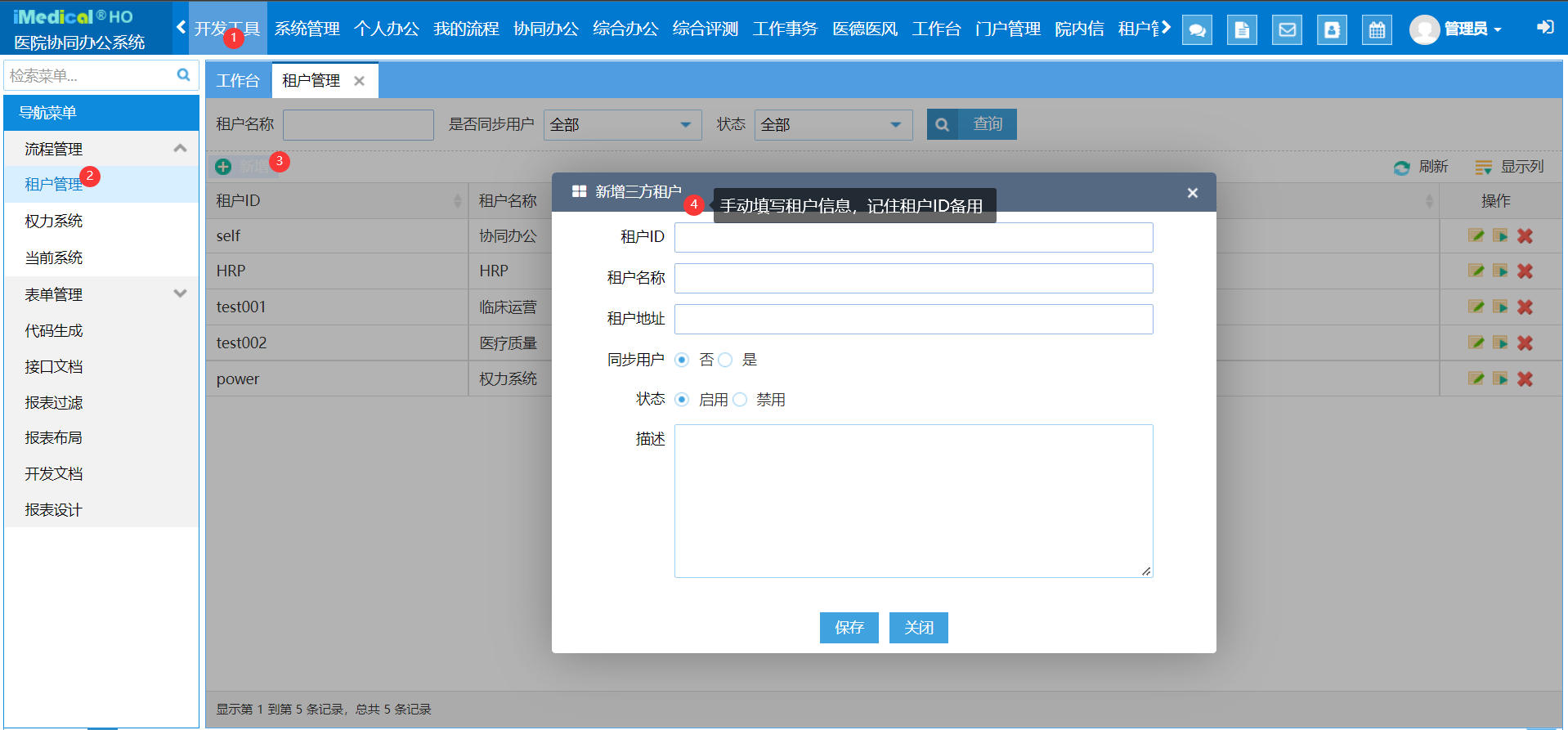
2.配置通用接口。注册租户完成后,点击进入通用服务管理,配置所有统一用户平台可支持的基础信息接口,ip地址根据实际情况配置。配置如下图。
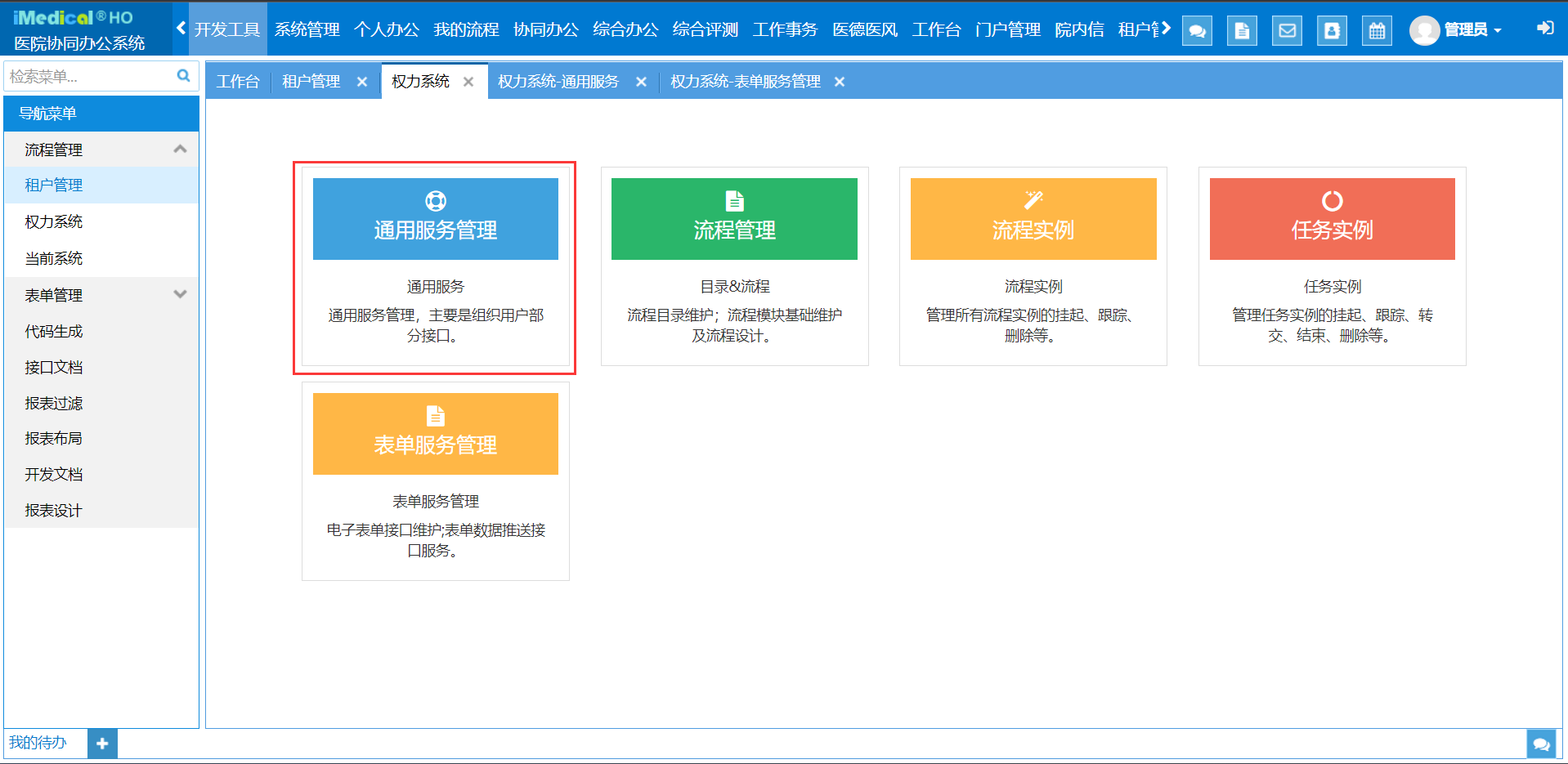
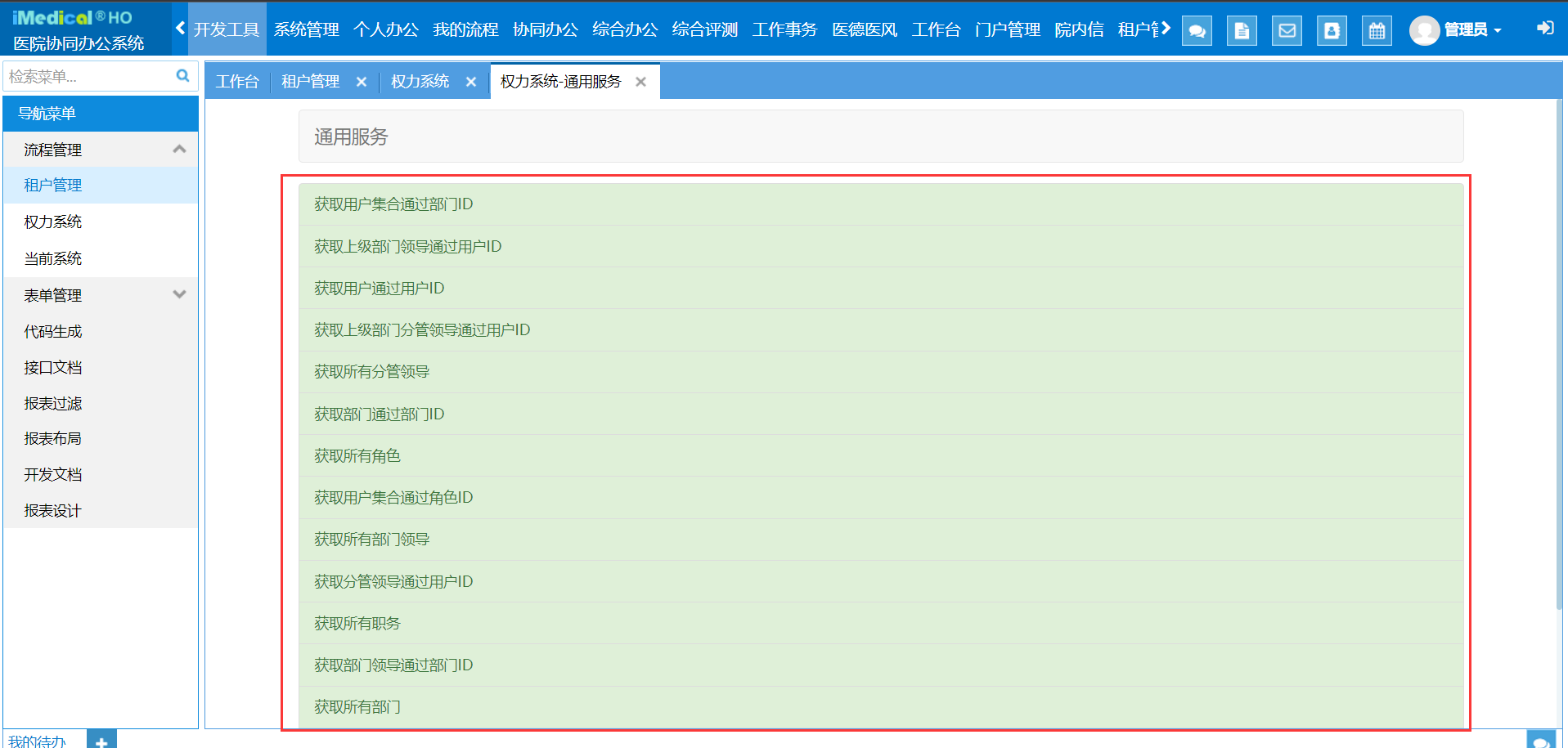
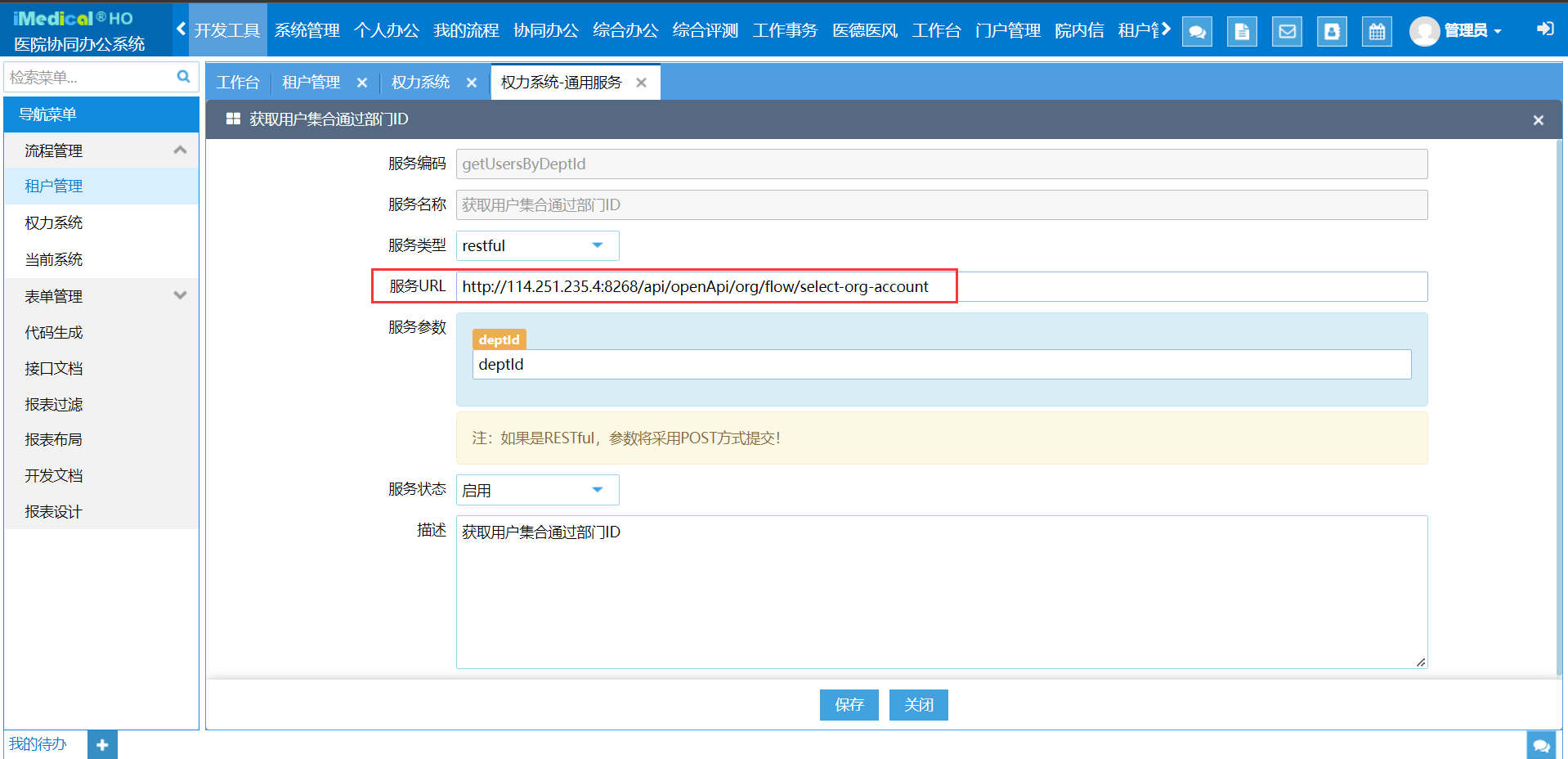
需要配置的16个通用接口(服务类型为restful)如下:
- 获取用户集合通过部门ID
编码:getUsersByDeptId
url:http://统一用户平台后端ip:port/api/openApi/org/flow/select-org-account
服务参数:deptId
- 获取上级部门领导通过用户ID
编码:getParentSuperiorByUserId
url:http://统一用户平台后端ip:port/api/openApi/org/flow/org-parent-leader-by-account-id
服务参数:userId
- 获取用户通过用户ID
编码:getUserById
url:http://统一用户平台后端ip:port/api/openApi/org/flow/select-account
服务参数:userCode
- 获取上级部门分管领导通过用户ID
编码:getParentLeaderByUserId
url:http://统一用户平台后端ip:port/api/openApi/org/flow/org-pb-leader-by-account-id
服务参数:userId
- 获取所有分管领导
编码:getAllSuperior
url:http://统一用户平台后端ip:port/openApi/org/flow/org-all-branch-leader
服务参数:无
- 获取部门通过部门ID
编码:getDeptById
url:http://统一用户平台后端ip:port/api/openApi/org/flow/orginfo
服务参数:deptId
- 获取所有角色
编码:getAllRole
url:http://统一用户平台后端ip:port/api/openApi/org/flow/get-all-role
服务参数:无
- 获取用户集合通过角色ID
编码:getUsersByRoleId
url:http://统一用户平台后端ip:port/api/openApi/org/flow/get-user-by-post
服务参数:roleId
- 获取所有部门领导
编码:getAllDeptLeader
url:http://统一用户平台后端ip:port/api/openApi/org/flow/org-all-leader
服务参数:无
- 获取分管领导通过用户ID
编码:getSuperiorByUserId
url:http://统一用户平台后端ip:port/api/openApi/org/flow/org-branch-leader-by-account-id
服务参数:userId
- 获取所有职务
编码:getAllPosition
url:http://统一用户平台后端ip:port/api/openApi/org/flow/get-all-prof
服务参数:无
- 获取部门领导通过部门ID
编码:getLeaderByDeptId
url:http://统一用户平台后端ip:port/api/openApi/org/flow/org-leader-by-id
服务参数:deptId
- 获取所有部门
编码:getAllDept
url:http://统一用户平台后端ip:port/api/openApi/org/flow/all-orginfo
服务参数:无
- 获取部门分管领导通过部门ID
编码:getSuperiorByDeptId
url:http://统一用户平台后端ip:port/api/openApi/org/flow/org-branch-leader-by-id
服务参数:deptId
- 获取所有用户
编码:getAllUser
url:http://统一用户平台后端ip:port/api/openApi/org/flow/select-all-account
服务参数:无
- 获取部门领导通过用户ID
编码:getLeaderByUserId
url:http://统一用户平台后端ip:port/api/openApi/org/flow/org-leader-by-account-id
服务参数:userId
3.配置回调接口。当表单审批结束后,需实时响应结果的业务要配置回调接口,ip地址根据实际情况配置。配置如下图。
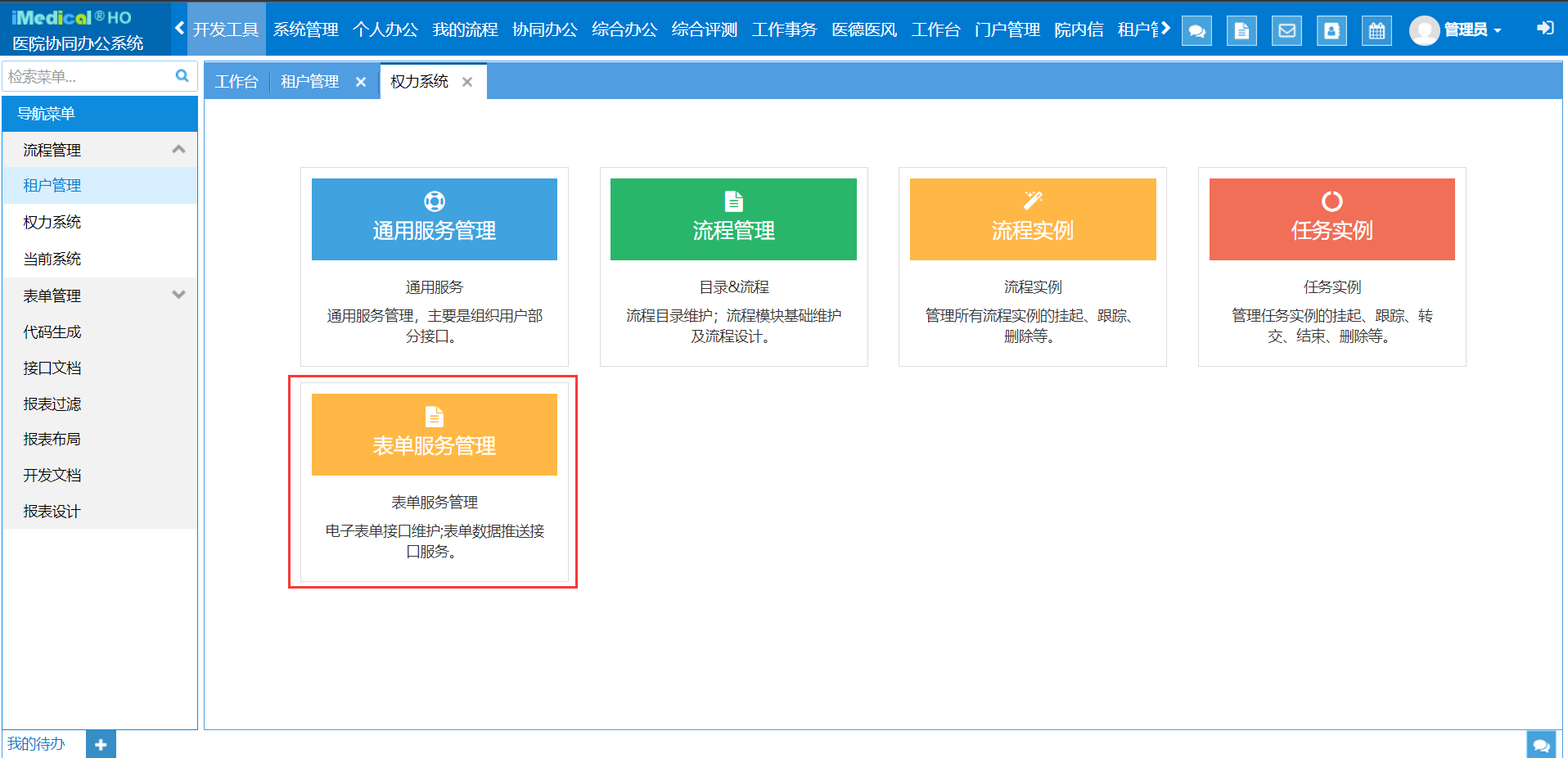
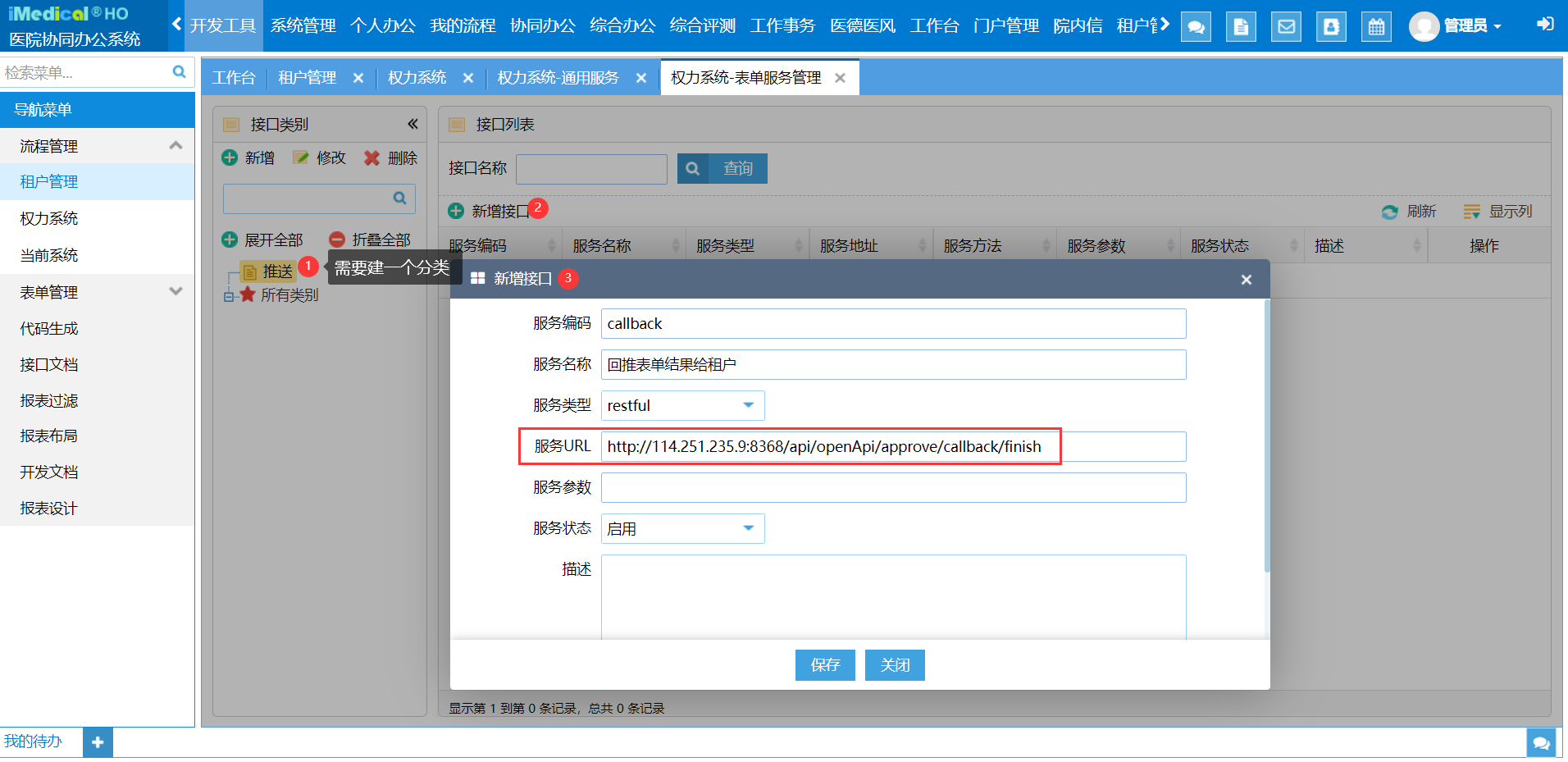
接口信息如下(服务类型为restful):
- hos推送接口
编码:hospush
url:http://统一用户平台后端ip:port/api/openApi/approve/callback/finish
# 服务总线
需要依赖服务总线系统,用于开放平台与其他应用系统(如门户引擎)的接口交互,具体服务总线的配置请联系服务总线相关人员。
# 开放平台服务发布
在服务总线中配置系统接入、服务发布,发布的10个接口如下:
- 同步账号
编码:USER
url:/hsb/HOSOpenService/account
- 同步角色
编码:ROLE
url:/hsb/HOSOpenService/role
- 同步岗位角色:
编码:POST_BU
url:/hsb/HOSOpenService/postRole
- 同步菜单:
编码:RESOURCE
url:/hsb/HOSOpenService/resource
- 同步数据权限:
编码:DATA_SCOPE
url:/hsb/HOSOpenService/scopeData
- 同步接口权限:
编码:INTERFACE
url:/hsb/HOSOpenService/interface
- 同步页面预置:
编码:PAGE_PRESET
url:/hsb/HOSOpenService/pagePreset
- 同步权限-同源:
编码:SYNCH_PERMISSION_SAME
url:/hsb/HOSOpenService/perms
- 查询资源-异构:
编码:QUERY_RESOURCE
url:/hsb/HOSOpenService/isomerismResource
- 同步权限-异构:
编码:SYNCH_PERMISSION_DIFF
url:/hsb/HOSOpenService/isomerismPerms
接口的请求方式
method:POST
content-type:application/json;charset=UTF-8
接口的请求数据结构
{
"Request":{
"Data":xxx,
"AppId":"m9Bweb0a87a3"
}
}
接口的响应数据结构
{
"code":"200",
"msg":"",
"data":xxx,
"success":true
}
在服务总线配置服务发布的示例如下:
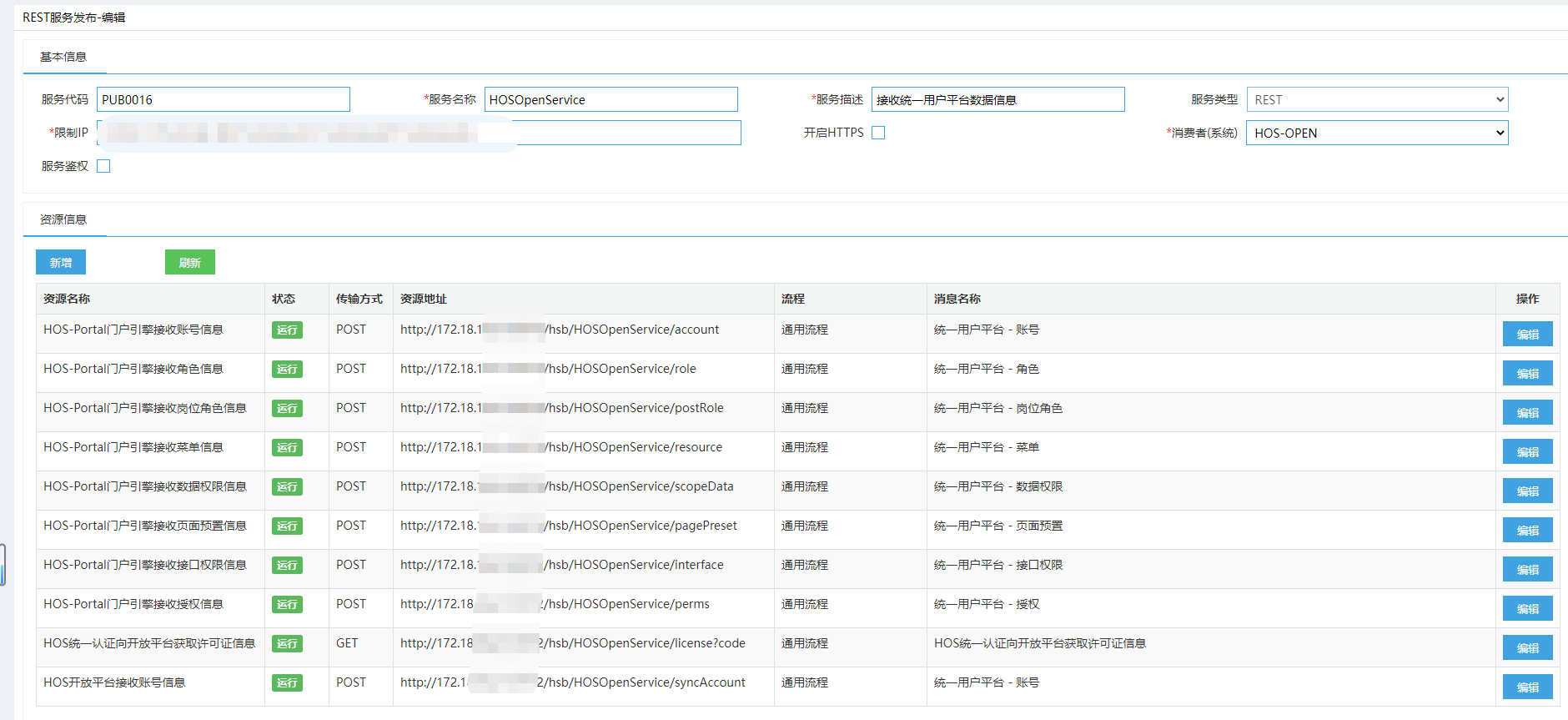
消息订阅:其他应用系统根据请求的数据结构中的AppId(具体AppId可到开放平台应用中心-应用管理-应用信息查看)进行消息订阅过滤,订阅的配置示例如下:

# 开放平台服务注册
在服务总线中配置系统接入、服务注册,需要注册的16个接口如下:
开放平台的8个接收同步数据的接口
- 接收账号:
编码:syncAccount
url:/api/openApi/sync/sync-account
- 接收角色:
编码:syncRole
url:/api/openApi/sync/syncRole
- 接收岗位角色:
编码:syncPostRole
url:/api/openApi/sync/syncPostRole
- 接收菜单:
编码:syncResource
url:/api/openApi/sync/resource
- 接收数据权限:
编码:syncScopeData
url:/api/openApi/sync/scopeData
- 接收接口权限:
编码:syncInterface
url:/api/openApi/sync/interface
- 接收页面预置:
编码:syncPagePreset
url:/api/openApi/sync/pagePreset
- 接收授权数据:
编码:syncPerms
url:/api/openApi/sync/perms
接口的请求方式
method:POST
content-type:application/json;charset=UTF-8
接口的请求数据结构
{
"Request":{
"Data":xxx
}
}
接口的响应数据结构
{
"code":"200",
"msg":"",
"data":xxx,
"success":true
}
同时开放平台还提供了1个接收主数据平台人员组织的接口,接口如下:
- 组织人员接收主数据平台的数据接口
编码:org-receive
url:/api/openApi/org/receive
接口的请求方式
method:post
接口的响应数据结构
{
"code":"200",
"msg":"",
"data":xxx,
"success":true
}
同时开放平台还提供了8个查询数据的接口,接口如下:
- 拉取应用账号信息:
编码:pullAccount
url:/api/openApi/uum/account/pull-account?appId&queryType&startTime&endTime
- 拉取角色信息:
编码:pullRole
url:/api/openApi/uum/role/pullRole?appId&queryType&startTime&endTime
- 拉取岗位角色信息:
编码:pullPostRole
url:/api/openApi/uum/postRole/pullPostRole?appId&queryType&startTime&endTime
- 拉取菜单信息:
编码:pullResource
url:/api/openApi/uum/resources/pull?appId&queryType&startTime&endTime
- 拉取数据权限信息:
编码:pullScopeData
url:/api/openApi/uum/scope-data/pull?appId&queryType&startTime&endTime
- 拉取接口权限信息:
编码:pullInterface
url:/api/openApi/uum/interface/pull?appId&queryType&startTime&endTime
- 拉取页面预置信息:
编码:pullPagePreset
url:/api/openApi/uum/page-preset/pull?appId&queryType&startTime&endTime
- 拉取同源授权信息:
编码:pullPerms
url:/api/openApi/uum/perms/pull?appId&queryType&startTime&endTime
接口的请求方式
method:GET
接口的响应数据结构
{
"code":"200",
"msg":"",
"data":xxx,
"success":true
}
上述17个接口需要在服务总线中配置服务注册,示例如下:
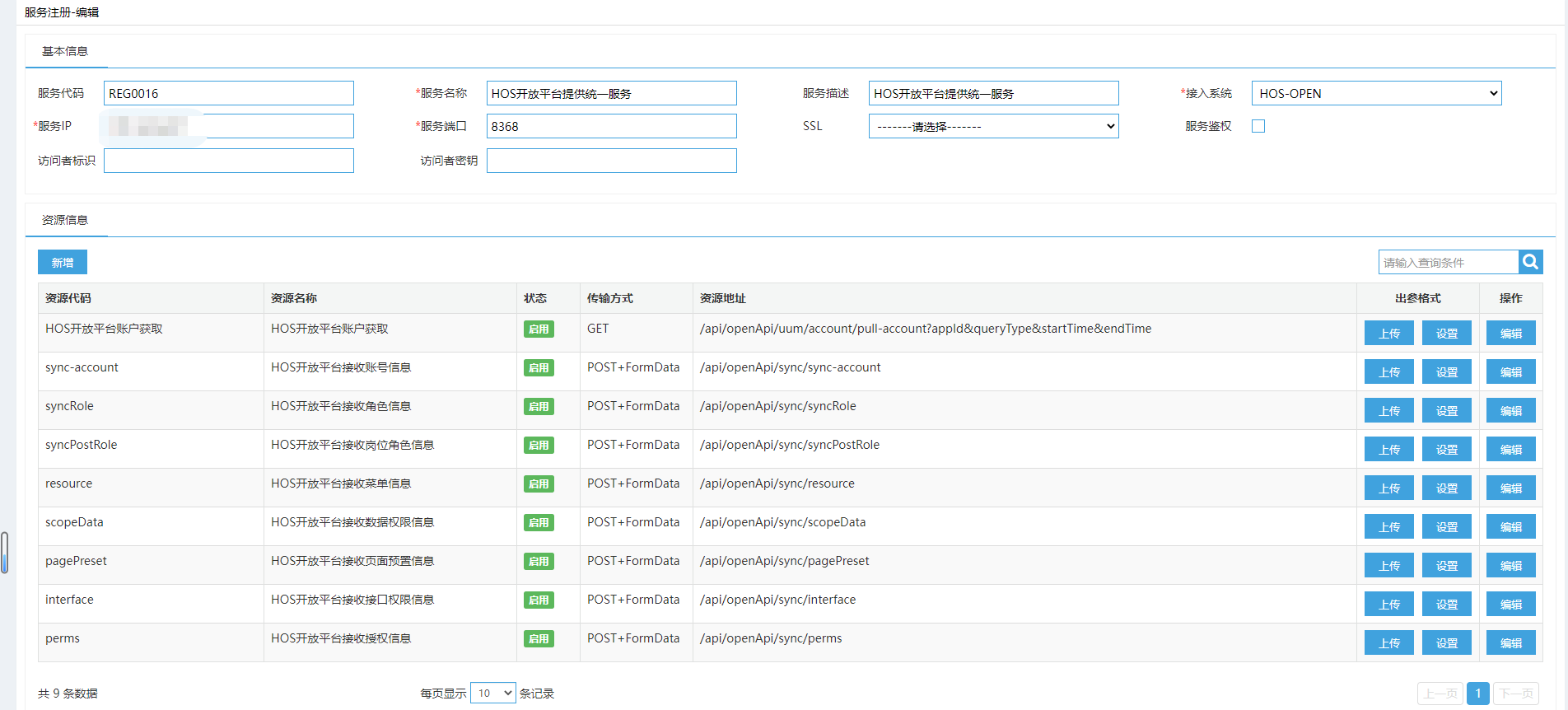
其他应用通过总线请求开放平台时,需要把开放平台作为订阅方在消息订阅中进行配置。
提示 服务总线系统针对外部访问拥有ip白名单限制,需要访问服务总线的应用需要把自己的ip提供给总线进行配置
# 主数据平台
开发中,暂不对接。
# https相关问题
如果协议不一致,http和https链接的互相访问,在较新版本的浏览器中会存在以下问题:
- 问题1:http网站中嵌入https链接时,如果https使用自签名ssl证书,则无法访问https链接;
- 问题2:https网站中嵌入http链接时,Chrome浏览器会把http转为https,导致无法访问。
首选的解决方案是所有链接采用相同的协议,比如都采用http。或者全都采用https。针对无法统一的场景,可以考虑以下临时方案:
# 准备测试人员手机号注意事项
特殊注意:维护人员手机号时,请务必注意不要随意虚构手机号,要么填写用户真实手机号(测试短信发送情况),要么填写“983xxxxxxxx”格式虚拟手机号,防止短信发送到真实手机号上。如果页面存在正则校验不能维护“983”开头手机号,则直接在数据库中写入手机号。
← 六、高级设置